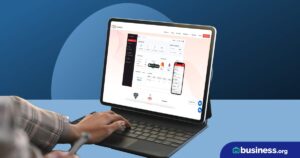💸 See if your business qualifies for a tax credit worth up to $26k per employee. 📞 Call Now: 855-979-9597
Fishbowl Inventory Review 2023
Data as of 2/28/23. Offers and availability may vary by location and are subject to change.
We are committed to sharing unbiased reviews. Some of the links on our site are from our partners who compensate us. Read our editorial guidelines and advertising disclosure.
Organizing inventory in a warehouse or manufacturing plant can be difficult, there are lots of moving parts and new shipments can add to the chaos. Having an inventory management system can make life easier for your business and employees.
Enter Fishbowl Inventory. Fishbowl offers inventory management software that is designed around your manufacturing and warehouse needs. With its one-time purchase fee, you can get everything you need upfront. It’s not perfect, though, so here’s everything you need to know before buying Fishbowl software.
Fishbowl is best for warehouse inventory and manufacturing
Fishbowl Inventory really covers everything you could want from an inventory management system. Both Fishbowl Warehouse and Fishbowl Manufacturing allow your business to grow by automating superfluous steps and making it easy to integrate with ecommerce and accounting systems.
The big plus here is with the specific software categories. Fishbowl Manufacturing is designed for assembly, disassembly, repair, replacement, and other manufacturing jobs. It helps with work orders and helps you streamline your manufacturing process to save time and money. On top of all of that, it still tracks inventory from manufacturing to delivery.
Fishbowl Warehouse is all about tracking inventory—from stock alerts and reordering to receiving and shipping goods. With the ability to follow inventory across multiple warehouses and scan product barcodes, you can be sure that your products are accounted for every step of the way.
Both of these inventory management programs function like enterprise resource planning (ERP) systems. ERPs are designed to streamline your business, combining inventory and accounting features with everything you need to complete daily operations all from a single platform.
Fishbowl pros and cons
Fishbowl pros
One of the biggest perks of using Fishbowl is you don’t have to pay monthly fees for your real-time inventory management software. That means you don’t have to worry about losing access to your inventory tracking if your business has a slow month or two.
Fishbowl’s also very easy to set up. The software is easy to implement—especially if you sign up for one of Fishbowl’s in-house or on-site training packages (for an extra cost, of course). And for QuickBooks users, it’s relatively simple to sync data between your accounting and inventory management programs.
Another thing we like? Fishbowl offers two types of products: one for warehouses and one for manufacturers. This gives you the flexibility to choose the right set of features based on your company’s needs—without overspending on a bloated system that delivers tons of options you don’t need.
Fishbowl cons
Fishbowl’s one-time cost is a bit of a double-edged sword. On the one hand, you don’t have to pay monthly fees for your system. On the other . . . Fishbowl’s up-front price may be a little steep for some businesses. Plus, the one-time purchase only provides you with updates and customer support for a year. You’ll need to fully resubscribe if you want to continue receiving updates and support yearly.
Unlike the competition, Fishbowl also doesn’t offer a lot of customization options for your software or reporting—at least not without significant programming experience. For starters, you’re stuck with average costing (where the system averages out the cost of your product from all your past purchases), so businesses that use first in, first out (FIFO) or last in, first out (LIFO) systems are straight out of luck. Furthermore, we’ve noticed that the software’s shipping functions can be very buggy.
The cherry on top is Fishbowl’s hit-or-miss customer service. When we reached out with some questions about our free trial, we got a quick, enthusiastic response at first. But as our questions got more advanced, it took longer and longer to hear back. We also noticed that the quality of service on phone calls varied a lot depending on the call center we reached.
By signing up I agree to the Terms of Use and Privacy Policy.
Fishbowl plans and pricing
Unlike many cloud-based inventory management options, Fishbowl isn’t an online solution. Instead, it’s a local software that lives solely on your computer.
Because it’s a one-time purchase, Fishbowl doesn’t offer package tiers or monthly pricing. Instead, you choose between two products: Fishbowl Warehouse and Fishbowl Manufacturing. Then you pay a single up-front fee to download the software.
The amount your business will pay depends on the number of users you have. Though Fishbowl doesn’t publish exact pricing on its website, we were able to get some extra details about how the pricing breaks down.
Fishbowl plans and pricing
Data as of 2/28/23. Offers and availability may vary by location and are subject to change.
The prices above entitle you to any software updates that Fishbowl releases for a year. After that, if you want to continue receiving updates to your software (along with any bug fixes and additional features those updates offer), you’ll need to renew your license for an additional fee. Fortunately, renewals cost significantly less—just $1,395 to $7,295 for Fishbowl Warehouse or $1,995 to $9,795 for Fishbowl Manufacturing.
In addition, Fishbowl also offers a number of add-ons. Fishbowl’s website mentions that you can get a free trial for each of them, but it doesn’t specify how much these add-ons cost (and our requests for more info went unanswered). But here’s what we do know:
- Fishbowl Anywhere gets you access to Fishbowl on all devices (including mobile devices).
- Fishbowl Checkout is a point-of-sale (POS) solution that lets you sync your sales to your inventory.
- Fishbowl Commerce delivers comprehensive inventory management functionality across multiple sales channels.
- Fishbowl for Salesforce adds your Fishbowl data to your Salesforce system so your salespeople can place and monitor orders, check inventory levels, and deliver superior customer service.
- Fishbowl Go allows you to perform cycle counts, barcode scanning, order fulfillment, and other warehouse functions from your Apple or Android device.
- Fishbowl Hosted Services is a server-hosting solution that allows you to enjoy secure, remote access to your Fishbowl file—plus your Microsoft Office files and more. Basically, it makes your inventory management system accessible via the cloud (not just on a single device).
- Fishbowl SalesPoint is another point-of-sale solution mentioned on Fishbowl’s website. It’s unclear whether it’s another name for Fishbowl Checkout or another product entirely. And unfortunately, Fishbowl hasn’t provided any clarification when we asked about the difference.
- Fishbowl ShipExpress helps you get price quotes from shippers, confirm customer addresses, print shipping labels, and create packing lists from your Fishbowl account.
- Fishbowl Time & Labor gives you an online time clock that your employees can access from their mobile devices. It can track and apply vacation time, overtime, and other payroll details, and (with Fishbowl Manufacturing) it can even add labor costs to work orders.
We’ll keep working to find out the specifics on these add-ons, but in the meantime, the only way to know how much they cost may be to just sign up.
Key features of Fishbowl
Fishbowl offers two separate software options: Fishbowl Warehouse and Fishbowl Manufacturing. While Fishbowl Manufacturing offers extra features that apply solely to manufacturing companies, the following features are available on both platforms.
Inventory management
If we’re being honest, Fishbowl’s inventory management features tend to be pretty run-of-the-mill. As you’d expect, you can track inventory levels, set up reorder points, and automate purchase orders (POs) for items you reorder on a regular basis.
Fishbowl also allows you to manage inventory across multiple warehouses and locations, which makes it easy to transfer products to prevent shortages. You can also create reports to study sales trends within each individual location.
That’s all fairly standard, but Fishbowl does offer one feature we haven’t seen from many other providers: the ability to designate testing locations. This is especially helpful for businesses that do heavy research and development since the inventory allocated to your testing location gets used instead of sold. With this feature, you can easily monitor how much inventory your testing locations use, and you can track for that inventory appropriately in your accounting software.
Multi-currency capabilities
One of the upsides to having inventory management software for QuickBooks users is you get some advanced financial features like multi-currency capability.
Fishbowl’s multi-currency feature lets you both create and receive sales orders and purchase orders in any currency. That means if you receive a sales order from a client in France, Fishbowl will convert the prices to your local currency. Likewise, any purchase orders made to international vendors can be sent in the vendor’s local currency.
For even greater ease of use, Fishbowl also allows you to assign currencies to certain vendors and customers. That way, Fishbowl can automatically convert any sales orders or POs you send or receive to the correct currency.
Part tracking
Fishbowl’s inventory management features may be nothing to write home about, but it does one-up other inventory control software by offering real-time tracking for each individual part (rather than entire products).
This feature allows you to track the location and status of each individual part used to make your products—right down to its bin or shelf number in your warehouse. You can track parts by lot number, serial number, revision date, expiration date, or tag number, so you have lots of flexibility to monitor your inventory in the way that makes the most sense to you.
Best of all, this feature also tracks costs for each part, including manufacturing prices, storage fees, and labor costs. Ultimately, this helps you reach the most accurate possible cost of goods sold (COGS) when you balance your books (which in turn helps you get a better picture of the health of your business).
Sales and purchasing
Fishbowl software also comes with a sales and purchasing module, which can help you set up pricing tiers, upgrade and customize products, and turn price quotes into sales orders. You can even set up quick lists for regular customers, which allows your warehouse to quickly fulfill recurring orders.
We also like that Fishbowl lets you set up customer groups. Within a customer group, you can set up client-specific discounts and variable pricing, which ensures you always offer the correct price to your wholesale or loyalty program customers.
Shipping
When it comes to shipping features, Fishbowl tries really, really hard. The platform includes embedded UPS shipping features, so you can (theoretically) print everything you need to pick, pack, and ship customer orders—all within your Fishbowl software. Plus, Fishbowl offers integrations with all major shipping providers.
In practical use, though, we found Fishbowl’s shipping features to be buggy and inefficient. In fact, some users report that they often had to change packing lists to reflect accurate carton counts (because the system glitched and didn’t report carton counts correctly), leading to a lot of frustrating manual work. That’s not great when you consider most business owners get Fishbowl so they can move away from manual inventory tracking.
Reporting
Fishbowl also offers a decent amount of reporting on your inventory, organizing all your sales and product data into graphs and forecasts.
Specifically, we like the Gross Sales Product report (which can identify the salespeople and products that are performing best) and the Turnover Bar Graph or Pie Chart (which lets you see the number of times you’ve sold all your inventory within a given year).
However, our favorite report has to be the Adjustment Report, which shows all the recent updates Fishbowl has made within your QuickBooks accounting figures. That way, you can check to make sure your inventory system is correctly syncing up with your QuickBooks accounting.
Fishbowl’s reporting feature is a bit behind the curve, though, as you don’t get a lot of freedom to play with your data. In fact, if you want any custom reports that aren’t already included, you’ll either have to reach out to Fishbowl customer service and wait for an expert to build the report for you or you’ll have to program your Fishbowl software to include the report you want.
Advanced work orders
Fishbowl Manufacturing has a lot of advanced features that make it easy to create and customize work orders—both individually and in batches.
For starters, Fishbowl lets you automate custom, batch, and repair work orders, so you don’t have to create common work orders manually. Work orders can also include lot tracking, serial number tracking, work order instructions, and build calculations.
Plus, you can group multiple work orders together to create overarching manufacturing orders, with scheduled tasks that can be assigned to individual workers. That’s particularly helpful when you’re building products with multiple components.
You can also create multi-level work orders that make use of multiple production stages. This allows you to track the progress of work orders through every phase of production and ensure everything in your business stays on schedule.
Advanced bills of materials
Similarly, Fishbowl Manufacturing also lets you create multi-level bills of materials (BOMs). With this feature, you can easily track costs and material requirements on an item-by-item basis.
Fishbowl also lets you create and fulfill multiple BOMs simultaneously, and any BOMs you create can be saved and duplicated for easy use on popular, frequently ordered products. Ultimately, this makes your business more efficient while also helping your clients streamline their supply chain management.
Fishbowl is great for QuickBooks users
If your business is committed to managing your accounting with QuickBooks, Fishbowl may be the best inventory tool for your business.
While other inventory management software is merely compatible with QuickBooks, Fishbowl was designed specifically to fill in the gaps left in QuickBooks’ inventory management features. Fishbowl’s interface is pretty similar to QuickBooks’, so it’s easy for QuickBooks veterans to pick up. And like QuickBooks, your software lives on your computer, not the cloud—meaning you’re able to manage both your accounting and inventory offline without disabling any of your system’s features.
Keep in mind, though, that Fishbowl is still a good inventory solution if you don’t have QuickBooks. So if you can’t stand QuickBooks’ interface or want a cheaper accounting software, you can still use Fishbowl with few to no problems.
That’s not to say, of course, that TradeGecko won’t work for retail or e-commerce businesses. Far from it—the Founder plan is practically made for single-location retail stores. And the service offers integration with WooCommerce, Amazon, Shopify, and tons of other e-commerce platforms, so you can sell products online with ease.
Fishbowl integrations
In addition to easy QuickBooks integration, Fishbowl offers a decent number of other integrations to help you customize your business management:
- Accounting—QuickBooks, QuickBooks Online, Avalara, Reckon, and Xero
- Customer relationship management (CRM)—Salesforce, Zoho
- Ecommerce—Shopify, WooCommerce, BigCommerce, Volusion, Magento, and Amazon
- Electronic data interchange (EDI)—SPS Commerce, TrueCommerce
- Hosted services—Amazon Web Services (AWS)
- Merchant services—Square, Authorize.net, CardConnect, PayPal
- Mobile hardware—Android, Apple, Microsoft Surface, Motorola, Wasp, Zebra
- Platforms—Android, Apple, Linux, Windows
- Point-of-sale (POS)—Intuit Point of Sale
- Shipping—DHL, FedEx, ShipStation, ShipRush, USPS, UPS
- Other—Dropbox, LilyPad, Metrc, Solidwords
Ease of use
By all accounts, Fishbowl is very easy to set up, with some users claiming it took only minutes to get their system up and running. This is largely due to Fishbowl’s excellent onboarding and training. The platform provides a comprehensive support site with tons of articles geared toward solving common problems and walking you through the setup process.
Alternatively, you can sign up for an hour of remote training (with a Fishbowl expert calling in via phone or video)or a two-day training workshop either at your business or on-site at the Fishbowl headquarters. Extra onboarding assistance will cost you, though—anywhere from $225 per hour to $2,947.50 per day.
That said, Fishbowl’s lack of customization options may make it difficult for some businesses to use. And even if it offers all the features you need, it may take months to get your inventory management system dialed in to the point that it actually works right for your business.
Fishbowl can also be quite buggy and slow. Each update makes the program bigger and more difficult to run, so some users may experience glitches and lagging while using the software. In fact, we suspect that this is the primary cause of the pick and pack issues we mentioned above.
Customer service
We like that Fishbowl goes above and beyond by offering additional training for businesses that are new to the software. But on the whole, we’ve found that Fishbowl’s customer service tends to be . . . unreliable.
Now, don’t get us wrong: during our research for this article, we worked with at least two really good customer support members. They responded to our requests for information promptly via email, and the answers they provided were in-depth and thorough—a refreshing change from the sales-focused customer support we’ve seen from other platforms.
However, we also had our fair share of bad experiences with Fishbowl. When we reached out to ask about pricing on Fishbowl’s add-ons, we got no response back, despite multiple attempts to contact a representative. And we were less than impressed to find that Fishbowl’s on-site “chat” feature wasn’t actually a chat feature at all—just a cleverly disguised email contact form.
On the whole, we’d say it was a mixed bag. So if you’re experiencing trouble with your software or have a question about a feature, you may be better off searching Fishbowl’s support site or hitting a forum.
The takeaway
Fishbowl Inventory isn’t a perfect inventory management solution. The customer service is spotty, it’s hard to customize the platform to fit your business’s unique needs, and the software doesn’t offer many features that make it stand apart from other inventory management systems.
However, where it does excel is in providing software for a business’s manufacturing and warehouse needs. CRM integrations allow you to track orders while the warehouse software manages products across locations. Plus, the combination of Fishbowl Manufacturing and QuickBooks is unparalleled because you can immediately track cost from the start of production to the moment you sell.
Fishbowl Inventory is a relatively easy-to-use inventory system that syncs with your accounting program for greater accuracy and insight into your business’s performance.
Fishbowl is one of our top five inventory management providers, but it’s not right for every business. Check out our other favorite inventory management platforms to see if another solution is best for you.
Related reading
Fishbowl FAQs
Fishbowl is a local software (the kind that works on your computer without an internet connection) that helps you manage your inventory. Fishbowl offers two products: Fishbowl Warehouse (for standard retail or wholesale inventory management) and Fishbowl Manufacturing (for, you know, manufacturers).
Fishbowl offers different prices for its two software products. For Fishbowl Warehouse, prices range from $4,395 to more than $23,000, depending on the number of users on your software license. Meanwhile, Fishbowl Manufacturing is a bit more expensive, ranging from $6,495 to over $31,000.
That’s pretty steep, so it may not be a practical choice for many small to mid-sized businesses. The good news? It’s a one-time up-front fee—no monthly payments required. Check out the pricing section above for more details.
What’s the difference between Fishbowl Warehouse and Fishbowl Manufacturing?
Fishbowl Warehouse and Fishbowl Manufacturing are two different inventory products offered by Fishbowl. Fishbowl Warehouse is a warehouse management software, so it includes many of the standard inventory management features used by retailers, wholesalers, and other types of small businesses.
Fishbowl Manufacturing offers all the same features as Fishbowl Warehouse, plus some manufacturing-specific capabilities (like the ability to produce advanced work orders). Because it includes more features, Fishbowl Manufacturing is also a tad more expensive than Fishbowl Warehouse.
While you certainly can track your inventory manually or via an Excel spreadsheet, it can be time-consuming and result in more accounting errors. Inventory management software may cost a bit more, but we think it’s worth it when you consider the insight they deliver on the health and status of your business. Or you can always go with one of the free inventory software options on the market.
Methodology
To come up with our star ranking and review for Fishbowl Inventory, we looked at pricing, features, integrations, reporting, platforms, and customer service. Our scores are subjective and based on available features at the time. Everything is subject to change if there are updates to the software.
Disclaimer
At Business.org, our research is meant to offer general product and service recommendations. We don't guarantee that our suggestions will work best for each individual or business, so consider your unique needs when choosing products and services.












